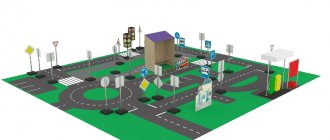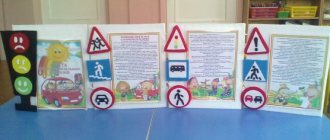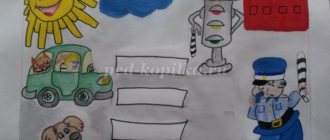2.5. In the event of a traffic accident, the driver involved in it is obliged to:
(Article: 2.5. In case of a traffic accident, the driver involved in it is obliged:)
- immediately stop (do not move) the vehicle, turn on the hazard warning lights and display an emergency stop sign in accordance with the requirements of paragraph 7.2 of the Rules, do not move objects related to the incident;
- take measures to provide first aid to the victims, call an ambulance, and in emergency cases, send the victims on a passing one, and if this is not possible, deliver them in your vehicle to the nearest medical facility, provide your last name, vehicle registration plate (with presentation identification document or driver's license and vehicle registration document) and return to the scene of the incident.
- clear the roadway if the movement of other vehicles is impossible. If it is necessary to clear the roadway or deliver victims in your vehicle to a medical facility, first record in the presence of witnesses the position of the vehicle, traces and objects related to the incident, and take all possible measures to preserve them and organize a detour to the scene of the incident;
- report the incident to the police, write down the names and addresses of eyewitnesses and wait for the arrival of police officers.
Travel speed
(Article: 10. Movement speed)
10.1. The driver must drive the vehicle at a speed not exceeding the established limit, taking into account the intensity of traffic, the characteristics and condition of the vehicle and cargo, road and meteorological conditions, in particular visibility in the direction of travel. If a traffic hazard arises that the driver is able to detect, he must take possible measures to reduce the speed until the vehicle stops.
10.2. In populated areas, vehicles are allowed to move at a speed of no more than 60 km/h, and in residential areas and courtyard areas no more than 20 km/h.
10.3. Movement outside populated areas is permitted:
- for cars and trucks with a permissible maximum weight of no more than 3.5 tons on highways - at a speed of no more than 130 km/h, on other roads - no more than 90 km/h.
Damage caused
The most obvious damage from road traffic accidents is death. Although even with this definition, not everything is so simple. For example, in the United States, a motor vehicle death is defined as the death of a person within 30 days of the accident. In Europe they work on the same principle. In Russia, a 30-day period was introduced in 2009 (before that, people who died within seven days were considered dead from road accidents).
Another factor that makes it difficult to count the dead is deliberate cover-ups and mistakes. The police are often involved. Even in the most prosperous and law-abiding countries, police sometimes do not report deaths.
It is almost impossible to calculate how many people were injured; the difficulties with determining mortality were indicated above; it is not difficult to guess what happens with non-fatal accidents.
Cases when a participant in an accident is not hospitalized are not uncommon . In the Netherlands, they even conducted an experiment, during which they found that the police register only 40% of victims.
Property damage is counted in even fewer cases than injuries. Losses in serious accidents are often recorded. Moreover, there is a certain amount that the damage must exceed in order for it to be registered. There are often situations where special services are not called, when drivers reach an agreement among themselves and “resolve the issue on the spot.”
Impact of the road network
A simple road with one lane in each direction is very dangerous in the sense that this is where the worst accidents occur. This is explained quite simply: drivers do not calculate the distance when overtaking, fall asleep or get sick and crash into an oncoming car. However, it is worth noting that the intensity on such roads is not the highest.
If there is a wide median or barrier, then the risk of a head-on collision is eliminated. However, a new problem arises - a person may lose control of the vehicle and collide with this very barrier, which also leads to serious accidents.
There are roads that practically eliminate the possibility of a car colliding with a person or animal. First of all, these are roads of the first technical category (motorways), where there are no pedestrian crossings.
Providing additional areas for parking and stopping a vehicle, as well as preparing for right and left turns, reduces the likelihood of collisions with stationary vehicles.
Equipping intersections with traffic lights also reduces the likelihood of violations and collisions of cars moving along an intersecting path.
The geometry of the road is also important . A long straight road has a negative impact on the driver due to its monotony - the person gets tired or loses the sense of speed. All this only increases the severity of the consequences of an accident.
Every day we go out or go out onto the streets, move in one direction or another by car, bicycle, public transport or on foot. In any case, you need to know and follow the rules of the road so as not to endanger yourself and other people on the road.
In conditions of heavy traffic, the number of road accidents involving minors increases.
We bring to your attention a thematic lesson (class hour) “Compliance with traffic rules - the path to personal safety” for students in grades 5–7. This lesson will help students learn traffic rules and master safe behavior skills on the streets and roads of the city, will contribute to the acquisition of knowledge and skills to protect life and health in dangerous road situations, and will teach how to create a safe route “Home - school - home”.
Authors: T. V. Subbotina, V. G. Zubkov
Recommendations for working with the presentation of the thematic lesson (class hour) “Compliance with traffic rules - the path to personal safety” for students in grades 5–7
Lesson option [PDF] [DOCX]
Presentation [PDF] [PPTX]
Student assignments [PDF] [DOCX]
Additional material for teachers [PDF] [DOCX]
Goal: creating a culture of safe behavior on the roads.
Tasks:
- to form in children an understanding that traffic rules are the law for all road users;
- teach children to navigate the “Rules of the Road”;
- form a clear idea of pedestrian discipline;
- to form in children a negative attitude towards violators of traffic norms and rules;
- teach how to create a safe route “Home - school - home”.
Equipment: multimedia equipment, laptop, tablet; sheets with diagrams of the territory of the district where the educational organization is located; felt-tip pens, colored pencils.
The methodological material is of a recommendatory nature. Taking into account the characteristics of each class, the teacher can vary the tasks, their number and stages of the lesson.
For reference:
Road accidents are one of the serious problems in our society, and it is believed that one of the reasons for this problem is the lack of culture of road users: their lack of discipline and non-compliance with traffic rules.
Question:
How do you think traffic rules and personal safety are related?
Based on the students’ answers, the class teacher formulates the purpose and objectives of the class hour.
Questions:
- What do you know about traffic rules?
- Why do you need to know and follow these rules?
- Who are road users?
The teacher determines the level of children's knowledge of traffic rules and comments on the students' answers.
The teacher talks about the Traffic Rules of the Russian Federation, focusing in more detail on the section “Responsibilities of Pedestrians” (see “Additional Material for Teachers”).
Exercise:
Look at the slide and explain the rule for crossing the road.
Questions:
- What is a crossroads?
- Why is an intersection dangerous for pedestrians?
- What rules must be followed when crossing an intersection?
Questions:
- What do traffic lights mean?
- What does a flashing yellow traffic light signal indicate?
- How to cross the street if the traffic light is flashing yellow?
Question:
- Why do you have to look when crossing the roadway, turning your head to the right and left, even if there are no cars on the road at the moment?
Question:
- Why can't you play on the road or near the road?
(You can hold a competition among students: name the greatest number of reasons why you can’t play on the road.)
Discussion of the situation:
- What is the danger of the situation depicted on the slide?
- What traffic rules were violated?
Question:
- What is the danger of the situation depicted on the slide?
Question:
- Why can't you walk on the roadway?
Assignment for students:
The slide names only one of the reasons why children get into accidents at stops more often than at intersections. Give other examples.
Exercise:
The class is divided into three groups. Each group receives the task of working with the rules of behavior for pedestrians and drawing up a safe route “Home - school - home”. To complete the task, the groups are given sheets with diagrams of the territory of the district of the educational organization.
Each route being developed can be discussed in class, where a group of students - the developers of the route sheet - must explain its content.
The class teacher talks about recommendations for developing a route sheet, which combines diagrams and descriptions of the route of schoolchildren from home to school and back.
The main goal of the route sheet is to improve the student’s traffic safety and teach him how to navigate traffic situations.
Having chosen a movement option, students plot it on a map of the streets from home to school.
The class teacher draws the attention of students to the fact that if the route includes a trip by public transport, then the diagram should show the location of the streets near the house (place of boarding public transport) and the location of the streets near the school (place of exit from public transport and movement to school ).
Students, while completing the task, highlight areas of increased danger on the diagram.
This is usually:
- leaving the house and crossing the street for the first time;
- crossing streets and intersections;
- boarding and exiting public transport (stop).
Areas of increased danger on non-recommended travel options are highlighted to explain why they are dangerous and why they are not recommended.
The class teacher draws the attention of schoolchildren to the description in the route of crossing the street if it is not regulated by a traffic light.
The class teacher draws the students' attention to the description in the route of crossing the street if it is regulated by a traffic light.
Students, working in groups, discuss the characteristics of the streets along which they walk to school.
Students remember the rules for boarding public transport, if necessary, enter this information into the route sheet.
Students remember the rules for exiting public transport and, if necessary, enter this information into the route sheet.
At the end of the group work, they are asked to think and answer the question “What should I title this slide?”
(You can hold a competition for the best slide title.)
At the final stage of the class hour, situational problems are considered for reflection (application). Students receive individual assignments. These can be text or test tasks (application).
The class teacher sums up the class hour.
Road traffic accidents
An accident is an event that occurred while driving along a road lane involving a vehicle, and in which people, vehicles, structures, cargo, equipment were injured, or other material damage was caused. Moments when a pedestrian fell on the road or was hit by a crowd are not taken into account.
Road accidents are the biggest threat to humans . The damage from motor vehicle accidents exceeds the damage from all other accidents combined (involving airplanes, trains, ships, etc.). But the problems don’t end there - according to statistics, the victims in such incidents are mostly healthy and young people.
The World Health Organization reports that the toll is rising every year, amounting to 1.36 million deaths per year. In 2021 alone, 19,088 people died on Russian roads; in the USA, this figure is 35,000. For every 100 thousand population in the Russian Federation, there are 13.8 deaths, while in Europe this figure is 5. According to statistics, since the 20th century , more than 3 million people died on the roads of the United States, which is more than the losses in all the wars in which the country participated.
Road accidents cause enormous material, demographic and social damage to the Russian economy. From 2007 to 2021, 272 thousand people died in our country, more than 2.5 million were wounded, 227 thousand children were injured, more than 9 of them received fatal injuries. Approximately a third of the victims are the working population aged 26 to 40 years. 20% remain disabled for life.
Each year, economic losses due to traffic accidents account for 2 percent of the country's GDP. Absolute indicators are equal to the GDP of regions such as the Krasnodar Territory or the Republic of Tatarstan.
According to traffic police statistics, in 2021 the rates of car accidents caused by alcohol intoxication increased. Compared to 2017, this figure increased by 1.2 percent. The number of wounded increased by 1.4%. The death toll remained the same. In almost every eighth accident, the drivers were either drunk or refused to undergo a medical examination.
When road safety is studied, various factors are identified that influence the severity and frequency of accidents. Not all road accidents are considered random events - for example, about 5% are suicides, and a certain number are murders. In addition, other factors are taken into account, so that the wording “accident” is now almost never used. Someone must be held accountable.





